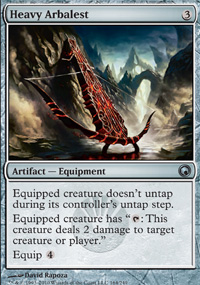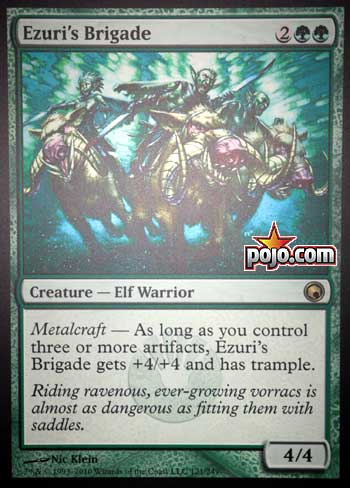

BMoor's
Deck Garage Home
Pojo's MTG
MTG Home
Message Board
News & Archives
Deck Garage
BMoor
Dolf
BeJoSe
Columnists
Paul's Perspective
Jeff Zandi
DeQuan Watson
Jordon Kronick
IQ
Aburame Shino
Rare Hunter
Tim Stoltzfus
WiCkEd
Judge Bill's Corner
Trading Card
Game
Card of the Day
Guide for Newbies
Decks to Beat
Featured Articles
Peasant Magic
Fan Tips
Tourney Reports
Other
Color Chart
Book Reviews
Online Play
MTG Links
Staff
120x90 Ad Space
For Rent!
|
 |
BMoor's Magic
The
Gathering Deck Garage
Scars of Mirrodin Prerelease Primer
September 23, 2010
Salutations, folks. At this point it should go without
saying that everybody in the Magic world is, in one way or
another, gearing themselves up for the release of Scars of
Mirrodin. Be it by examining their Standard decks and
figuring out what to play post-rotation, searching the
Internet for preview cards that would go great in your Cube
drafts, or organizing a carpool to head down to the
prerelease, anybody who self-identifies as a Magic player
should be feeling the anticipation in some way, shape, or
form. For me,
 the lead-in to Scars of Mirrodin has seen me
prepare in three ways. First, I stop fixing decks until we
know the full set list, because I don't
want to give advice that will be rendered obsolete by next
week. Second, I make plans to be at the prerelease, or the
release, or both if I think I can spare the money. And
third, I write this article: my own Prerelease Primer. the lead-in to Scars of Mirrodin has seen me
prepare in three ways. First, I stop fixing decks until we
know the full set list, because I don't
want to give advice that will be rendered obsolete by next
week. Second, I make plans to be at the prerelease, or the
release, or both if I think I can spare the money. And
third, I write this article: my own Prerelease Primer.
Just because the bulk of my articles deal with Constructed,
60-card decks, doesn't mean I can't help some of you out
there with advice on building a 40-card Limited dynamo. And
just because prereleases are usually laid-back, low-K
events, doesn't mean you wouldn't enjoy winning a few
matches during the day-- especially considering some places
give out prizes to the winners. And preparation is what's
going to help you do that.
Mind you, preparing for Limited events is a thorny task,
since the whole point of Limited, be it Draft or Sealed, is
that you don't get to build your deck ahead of time. Each
participant is given equal amounts of product, and equal
chances of opening any given card, and you have to build
your deck on the fly. Prereleases offer even less
opportunity to prepare, since there's a good number of you
who will never have seen most of these cards, and memorizing
the spoiler lists from unofficial sites is not only more
work than it's worth, it leaves the potential for error.
Your best bet is to develop a system by which you can
quickly and efficiently asses your brand-new cards and build
a cohesive deck out of them. My plan for this article is to
share my own algorithm with you.
Now, prereleases are Sealed format, meaning that when deck
construction starts, you will be given six unopened booster
packs. For the rest of the day, those six packs are the
alpha and the omega, the only cards you have to work with.
 Hope you open something good! Hope you open something good!
Your first step, or at least my first step, is to sort by
color. Don't even read the cards yet, just make six piles--
one for each color and one for colorless. In most sets, the
colorless pile consists of a few artifacts and maybe a
colorless land, like Evolving Wilds. In Scars of Mirrodin,
with its heavy artifact theme, the colorless pile may be
your biggest pile of the six. In a way, this is good news--
if you have enough colorless playables, you don't have to
worry as much about the depth of a color you might want to
play. You can also play a bit more fast and loose with
splashes, secure in the knowledge that if you don't draw the
right color of mana, you can still cast a good portion fo
your spells off of any color.
Once your cardpool is sorted, look through each pile in turn
to determine what your best cards are, and how many you have
in each color. This is the part where the well-known
mnemonic BREAD comes in. Bombs, Removal, Evasion, Abilities,
Dudes. You've probably heard it before, but in case you
haven't, the first things you want to identify are your
bombs. Bombs are cards that generate an enormous advantage
for you when they resolve, and have the potential to win you
the game all on their own, in a fairly short time, if your
opponent doesn't have an answer to them. There's no real
hard definition as to what is a bomb and what isn't, but the
general consensus is that you'll know true power when you
see it.
From there it gets easier. Removal is any card that ca n kill
an opponent's creature. Almost all Limited games are won by
creature combat, so denying your opponent creatures can be
critical. This is especially true in a format like Scars of Mirrodin, which will have a higher-than-average amount of
playable Equipment. Even a 1/1 could pick up a greataxe, a
shield, and a bracer, and suddenly become a credible threat.
Then comes Evasion, creatures that have abilities that make
them harder to block, or cards that grant creatures such
abilities. Flying creatures have decided more games of
Limited than I care to count. Since outright creature kill
is fairly rare in Limited, most people depend on combat
tricks to lure opponents into an unwise attack or attack
into what looks like a hopeless block only to kill the
blocker. n kill
an opponent's creature. Almost all Limited games are won by
creature combat, so denying your opponent creatures can be
critical. This is especially true in a format like Scars of Mirrodin, which will have a higher-than-average amount of
playable Equipment. Even a 1/1 could pick up a greataxe, a
shield, and a bracer, and suddenly become a credible threat.
Then comes Evasion, creatures that have abilities that make
them harder to block, or cards that grant creatures such
abilities. Flying creatures have decided more games of
Limited than I care to count. Since outright creature kill
is fairly rare in Limited, most people depend on combat
tricks to lure opponents into an unwise attack or attack
into what looks like a hopeless block only to kill the
blocker.
The last two letters in the mnemonic, A(bilities) and D(udes)
are not universally understood to stand for anything
specific. This is because you ideally want to fill your deck
with Bombs, Removal, and Evasion. But there's a good chance
you won't get enough of those cards, and will have to fill
out your deck with the leftovers. As several players have
told me and I in turn have told several more, "every card in
your deck should either be a creature on your side, or
remove a creature on the other guy's side." This is
hyperbole, of course, but getting enough creatures is a
primary concern. Especially in a set with so much
Equipment-- you won't feel good if you get four or five epic
swords onto the battlefield only to not draw any creatures.
Especially if the other guy is swinging at you every turn
for two. ESPECIALLY especially if his 2/2 doesn't have any
evasion and you could easily block and kill it with any
creature in your deck. Hell, if you wanted to (and had
enough creatures and not enough non-creature cards) you
could probably go pretty far by just playing nothing but
creatures. Sure you'd have no removal, but if you attack
often enough your opponent's creature will eventually start
dying because he'll be forced to use them to block.
So anyway, that's what you need to include in your deck.
Sorting your cards by color allows you to quickly see which
colors have the most cards that rank highly enough for you
to play, and thus which colors you should play. Some of your
colors will undoubtedly be "deeper"-- have more playables--
than others. This can create a conflict where you open an
incredibly powerful card in a certain color, but the rest of
the cards in that color aren't strong enough for said color
to be a major portion of your deck. That scenario happened
to me at the M11 Release event. My six booster packs gave me
a Chandra Nalaar and a Liliana Vess, but black and red
didn't have much else going for them besides a few good kill
spells. I played black/red anyway, hoping I could use my
kill cards to hold the opponent's armies off long enough to
draw one of my planeswalkers and grind them down with it. It
didn't work out that way. Meanwhile, the white cards in that
pool had several more quality creatures, including several
fliers, and some good combat tricks. If I had played white
as my main color, I probably would have done much better and
may still have gotten to play one or the other of my lovely
lady planeswalkers, but I was seduced by the
high-risk/high-reward scenario and lost. Don't make this
same mistake. that rank highly enough for you
to play, and thus which colors you should play. Some of your
colors will undoubtedly be "deeper"-- have more playables--
than others. This can create a conflict where you open an
incredibly powerful card in a certain color, but the rest of
the cards in that color aren't strong enough for said color
to be a major portion of your deck. That scenario happened
to me at the M11 Release event. My six booster packs gave me
a Chandra Nalaar and a Liliana Vess, but black and red
didn't have much else going for them besides a few good kill
spells. I played black/red anyway, hoping I could use my
kill cards to hold the opponent's armies off long enough to
draw one of my planeswalkers and grind them down with it. It
didn't work out that way. Meanwhile, the white cards in that
pool had several more quality creatures, including several
fliers, and some good combat tricks. If I had played white
as my main color, I probably would have done much better and
may still have gotten to play one or the other of my lovely
lady planeswalkers, but I was seduced by the
high-risk/high-reward scenario and lost. Don't make this
same mistake.
Fortunately, you may not have to. As I said above, Scars of
Mirrodin will have more colorless cards than most sets do,
which means a good portion of your deck may be colorless. If
that is the case, then you won't need as many playable cards
in a given color to consider playing that color.
The next thing you need to look out for is cards that may
potentially have a lot of power, if you can successfully
build your deck in a way to maximize that power. A good
example would be Surreal Memoir from Rise of the Eldrazi.
Getting two instants back from your graveyard canbe huge in
letting you deliver that one big push in th e late game, when
you and your opponent have already used up your tricks. It's
practically "draw two cards" in red. But only if you have
enough instants-- if you only have two or three instant
spells in your deck-- a fairly common occurrence in
Limited-- Surreal Memoir won't be enough to help you. e late game, when
you and your opponent have already used up your tricks. It's
practically "draw two cards" in red. But only if you have
enough instants-- if you only have two or three instant
spells in your deck-- a fairly common occurrence in
Limited-- Surreal Memoir won't be enough to help you.
In Scars of Mirrodin, this will probably make itself most
apparent in the Metalcraft, Infect, and Proliferate
mechanics. Metalcraft straight-up tells you you need three
artifacts in play to make it work. This probably won't be
too hard to do, but do take a note of how many metalcraft
cards you're including and how many artifacts.
Infect is a little trickier. But remember, a creature with
infect will ALWAYS deal damage in the form of either -1/-1
counters or poison counters-- they can't deal normal damage.
So, if your opponent is at 1 life, and you topdeck a 3/3
with infect and swing, your opponent will gain three poison
counters... and still be at one life, and not lose unless
you already put seven or more poison counters on him
previously. If that 3/3 with infect is your only way of
doling out poison counters, any damage it deals to opponents
"won't count" unless it somehow manages to get in for a
total of 10 all by itself. Therefore, you'll want to include
either a good amount of infect creatures, or none at all. If
all you have is a single infect creature, that creature is
basically only good as a blocker, to deal -1/-1 damage to
any incoming attackers and shrink them. And since reading
"infect" as "defender" is almost always a serious drawback,
you're not going to want to run a creatrue like that.
Proliferate is in a similar boat. If you have cards that
proliferate, you're going to want a good supply of cards
that put counters on permanents or players. Any creature
with infect raises proliferate's stock, but so do artifacts
with charge counters, of which there are plenty.
Planeswalkers also benefit greatly from proliferate, but
there are few enough of them (and each one is a bomb anyway)
that planeswalkers likely won't factor into your decision to
include proliferate cards unless you're very lucky.
In a way, the problems I described earlier with havi ng
enough playable cards in a certain color are just another
form of this. Just as Surreal Memoir is only worth using if
you have enough instants, a card with a heavy color
commitment like Cyclops Gladiator is only worth using if
you have enough red cards in your deck to warrant a sizable
proportion of your lands being Mountains; otherwise you
won't be able to draw enough red mana sources to cast the
Gladiator until it's too late for it to do any good. In
short, you have to remember that you're not picking out the
best 22 or 23 cards in your pool, you're building a deck and
the cards you put in it need to work with each other
accordingly. ng
enough playable cards in a certain color are just another
form of this. Just as Surreal Memoir is only worth using if
you have enough instants, a card with a heavy color
commitment like Cyclops Gladiator is only worth using if
you have enough red cards in your deck to warrant a sizable
proportion of your lands being Mountains; otherwise you
won't be able to draw enough red mana sources to cast the
Gladiator until it's too late for it to do any good. In
short, you have to remember that you're not picking out the
best 22 or 23 cards in your pool, you're building a deck and
the cards you put in it need to work with each other
accordingly.
Of course, I could go on and on about Limited theorycrafting
and speculation on the new set, but if my articles had a
word count limit I'd surely have hit it by now. And what
I've said pretty much covers everythign I wanted to in this
article, so I'll wrap it up here. Just remember the most
important thing about prereleases-- their main goal is for
you to get your first taste of playing with the new cards in
an environment that's fairly casual and friendly but still
just competitive enough to warrant that little adrenaline
kick that comes with winning. If you plan to go to one, have
a great time, try and meet some new people, and of course,
good luck!
~BMoor
|



 the lead-in to Scars of Mirrodin has seen me
prepare in three ways. First, I stop fixing decks until we
know the full set list, because I don't
want to give advice that will be rendered obsolete by next
week. Second, I make plans to be at the prerelease, or the
release, or both if I think I can spare the money. And
third, I write this article: my own Prerelease Primer.
the lead-in to Scars of Mirrodin has seen me
prepare in three ways. First, I stop fixing decks until we
know the full set list, because I don't
want to give advice that will be rendered obsolete by next
week. Second, I make plans to be at the prerelease, or the
release, or both if I think I can spare the money. And
third, I write this article: my own Prerelease Primer.


 e late game, when
you and your opponent have already used up your tricks. It's
practically "draw two cards" in red. But only if you have
enough instants-- if you only have two or three instant
spells in your deck-- a fairly common occurrence in
Limited-- Surreal Memoir won't be enough to help you.
e late game, when
you and your opponent have already used up your tricks. It's
practically "draw two cards" in red. But only if you have
enough instants-- if you only have two or three instant
spells in your deck-- a fairly common occurrence in
Limited-- Surreal Memoir won't be enough to help you.